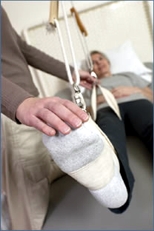|
 Ingrown Nails Ingrown Nails

An ingrown nail is the result of a nail growing into the skin that surrounds it.
This often occurs at either edge of the big toe. Ingrown nails may be caused by improper trimming,
inherited nail deformities, injuries, fungal infections, or pressure.
|
|
 Thickened
Nails Thickened
Nails 
Abnormally thick or crumbling nails may be caused by injuries, pressure from
shoes, fungal infections, or conditions such as diabetes, psoriasis, or vascular disease.
Eventually, the nail may loosen and fall off.
|
| |
|
|
|
|
|
Symptoms
|
|
|
Symptoms
|
|
| Ingrown nails may cause pain at the tip of the toe or all the way to the base of the
toe. The pain is often worse while walking. An ingrown nail may laso lead to infection,
inflammation, or a more serious condition. If it's infected, you might see pus or
redness. |
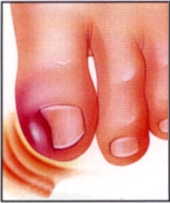
|
|
Along with thickening, the nail may appear ridged, brittle, or yellowish. The nail may also feel
painful when pressure is put on it
|
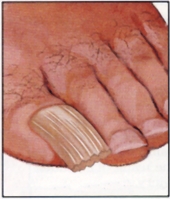
|
| |
|
|
|
|
|
Evaluation
|
|
|
Evaluation
|
|
| To determine the extent of your problem, the podiatrist can examine and possibly
palpate (press) the painful area. If other problems are suspected, blood tests, cultures, or
x-rays may be done as well. |
|
Since thickened nails may be a symptom of an underlying medical condition, it's
important for our podiatrist to look at your medical history for possible related problems. To
check for a fungal infection, a culture may be done. The thickness and color of the nail are
also examined carefully to determine possible infections or other conditions. |
| |
|
|
|
|
|
Treatment
|
|
|
Treatment
|
|
| If the nail isn't infected, your podiatrist may trim the corner of it to
help relieve your symptoms. He or she may need to remove one side of your nail back to the cuticle.
The baseof the nail is then treated with a chemical to keep the ingrown part from growing back.
Severe infections or ingrown |
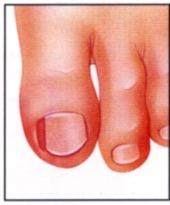
|
|
If the nail isn't infected, your pediatrist may be able to thin it by trimming,
filing, or grinding. If a fungal infection is present, oral or topical anti-
fungal medications may be needed. This can help prevent ulcerations under the nail while
keeping the fungus from spreading to other nails. If pain is still present, |
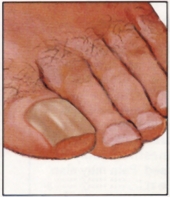
|
| nails may require antibiotics and temporary or permanent removal of a portion of the
nail. To prevent pain, a local anesthetic may be used in these procedures. This treatment is
usually done in our office. |
|
the entire nail or part of it can be surgically removed. Do not try to remove the nail
by yourself |
| |
|
|
|
|
|
 Black-And-Blue Nails Black-And-Blue Nails
A black-and-blue nail is usually caused by sudden or repetitive injury to a toe.
This might occur during sports that involve running or stopping quickly. The injury may also result
from a heavy object falling on a toe. If your toe is black and blue but not injured, see your
podiatrist immediately.
|
|
 Prevent Nail Problems Prevent Nail Problems
Many nail problems can be prevented by wearing the
right shoes and trimming your nails properly. To help avoid infection, keep your feet clean and
dry. If you have diabetes, talk with your podiatrist before doing any foot self-care.
|
| |
|
|
|
|
|
Symptoms
|
|
|
The Right Shoes
|
|
| The big toe is most often affected. Bruised, broken blood vessels cause the
black-and-blue colors under the nail. If the condition is the result of a sudden injury, pain may
be severe. |
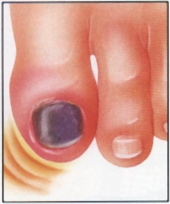 |
|
Get your feet measured (your size may change as you age.) Wear shoes that are
supportive and roomy enough for your toes to wiggle. Look for shoes made of natural materials such
as leather, which will allow your feet to breathe. |
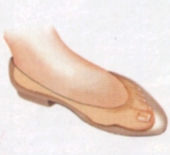
|
| |
|
|
|
|
|
Evaluation
|
|
|
Proper Trimming
|
|
| Your podiatrist talks with you about your symptoms and physical activities. He or she
may palpate (press) the area at the end of the toe to determine the extent of pain. Your toe and
foot are aexamined for any signs of infection. If a fracture or a bone spur is suspected, x-rays
may be needed. If small black spots are present under the nail, other problems may need to be ruled
out. |
|
To avoid problems, trim your toenails straight across without cutting down intothe
corners. If you can't trim your own nails, ask your podiatrist to do so for you. |
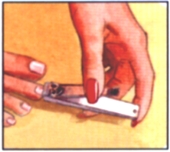 |
|
Treatment
|
|
|
|
|
|
If pain is sever, the nail may be removed, or a hole may be drilled in the nail to allow
drainage, which relieves the pressure. A local anesthetic may be used. Pain may also be relieved
with prescription medications, or by soaking or icing the area. If pain is not
|
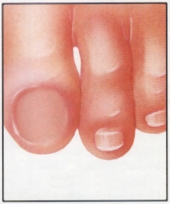
|
|
|
|
| severe, you may not need treatment. The nail can be thinned or left alone to fall off.
A new nail should grow to replace it |
|
|
|
| |
|
|
|
|

